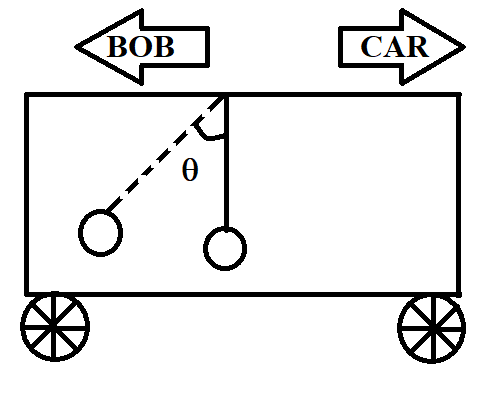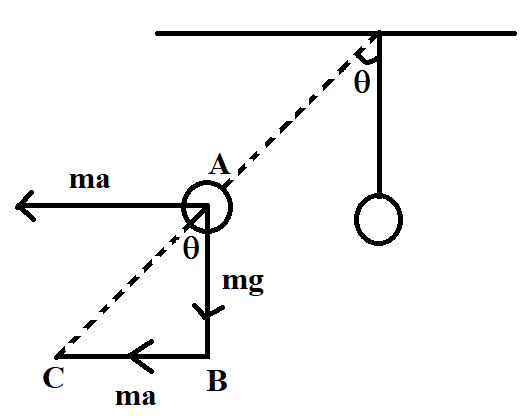
Answer
451.5k+ views
Hint: When the car starts moving, pseudo force acts on the plumb bob. This force will cause the plumb bob to move backwards, if the car is moving forward. Pseudo force is defined as the force that appears to be acting on a mass, whose motion is described using a non-inertial frame of reference.
Complete answer:
Pseudo force is defined as the force that appears to be acting on a mass, when the motion of mass is described in a non-inertial frame of reference. To understand this, let us take the example of a plumb bob, released from the ceiling of a car, as given in the question. We know that when the car starts moving forward, the plumb bob will move backwards, or the string attached to the plumb bob will get tilted towards the left, from its vertical position. The angle made between the tilted string and its vertical position is denoted as $\theta $, as shown in the following diagram. Here, the non-inertial frame of reference is the accelerating frame of reference of the moving car. When we describe the motion of the plumb bob with respect to this accelerating frame of reference of the car, it appears to be acted upon by a force. This force is nothing but a pseudo force.

Coming to our problem, we are required to find the value of $\theta $, which is the angle between the vertical position of the string and the tilted position of the string, as shown in the figure. At the tilted position, the bob experiences a force equal to the force with which the car is moving, but in the opposite direction. If $ma$ is the force acting on the car, the force on the bob is also equal to $ma$, but in the opposite direction, as shown. At the same time, gravitational force too acts on the plumb bob. This gravitational force is equal to the weight of the plumb bob and is given by $mg$. The direction of gravitational force is downwards, as shown.

Now, if we draw a triangle connecting the tilted bob, the force acting on the bob and the gravitational force as shown, it is obvious that angle $A$ of the right triangle $ABC$ is equal to $\theta $, due to the property of parallel lines. Now, we know that $\tan \theta $ in a right triangle is the ratio of its opposite side to the base of the triangle. Therefore, in triangle $ABC$, $\tan \theta $ is given by
$\tan \theta =\dfrac{BC}{AB}=\dfrac{ma}{mg}=\dfrac{a}{g}$
Taking $\theta $ outside, we have
$\theta ={{\tan }^{-1}}\left( \dfrac{a}{g} \right)$
Therefore, the angle made by the string with the vertical is ${{\tan }^{-1}}\left( \dfrac{a}{g} \right)$.
So, the correct answer is “Option A”.
Note:
Students need not get confused with the way $\tan \theta $ is calculated in triangle $ABC$. In the above solution, we have equated the sides of the triangle with vectors $m\overrightarrow{a}$ and $m\overrightarrow{g}$. Students need to understand that it is the ratio of these sides that is important and not the actual measurements of the sides, in order to determine the value of $\tan \theta $. Therefore, sides can be equated to the corresponding vectors, in the case of angle measurements.
Complete answer:
Pseudo force is defined as the force that appears to be acting on a mass, when the motion of mass is described in a non-inertial frame of reference. To understand this, let us take the example of a plumb bob, released from the ceiling of a car, as given in the question. We know that when the car starts moving forward, the plumb bob will move backwards, or the string attached to the plumb bob will get tilted towards the left, from its vertical position. The angle made between the tilted string and its vertical position is denoted as $\theta $, as shown in the following diagram. Here, the non-inertial frame of reference is the accelerating frame of reference of the moving car. When we describe the motion of the plumb bob with respect to this accelerating frame of reference of the car, it appears to be acted upon by a force. This force is nothing but a pseudo force.

Coming to our problem, we are required to find the value of $\theta $, which is the angle between the vertical position of the string and the tilted position of the string, as shown in the figure. At the tilted position, the bob experiences a force equal to the force with which the car is moving, but in the opposite direction. If $ma$ is the force acting on the car, the force on the bob is also equal to $ma$, but in the opposite direction, as shown. At the same time, gravitational force too acts on the plumb bob. This gravitational force is equal to the weight of the plumb bob and is given by $mg$. The direction of gravitational force is downwards, as shown.

Now, if we draw a triangle connecting the tilted bob, the force acting on the bob and the gravitational force as shown, it is obvious that angle $A$ of the right triangle $ABC$ is equal to $\theta $, due to the property of parallel lines. Now, we know that $\tan \theta $ in a right triangle is the ratio of its opposite side to the base of the triangle. Therefore, in triangle $ABC$, $\tan \theta $ is given by
$\tan \theta =\dfrac{BC}{AB}=\dfrac{ma}{mg}=\dfrac{a}{g}$
Taking $\theta $ outside, we have
$\theta ={{\tan }^{-1}}\left( \dfrac{a}{g} \right)$
Therefore, the angle made by the string with the vertical is ${{\tan }^{-1}}\left( \dfrac{a}{g} \right)$.
So, the correct answer is “Option A”.
Note:
Students need not get confused with the way $\tan \theta $ is calculated in triangle $ABC$. In the above solution, we have equated the sides of the triangle with vectors $m\overrightarrow{a}$ and $m\overrightarrow{g}$. Students need to understand that it is the ratio of these sides that is important and not the actual measurements of the sides, in order to determine the value of $\tan \theta $. Therefore, sides can be equated to the corresponding vectors, in the case of angle measurements.
Recently Updated Pages
Who among the following was the religious guru of class 7 social science CBSE

what is the correct chronological order of the following class 10 social science CBSE

Which of the following was not the actual cause for class 10 social science CBSE

Which of the following statements is not correct A class 10 social science CBSE

Which of the following leaders was not present in the class 10 social science CBSE

Garampani Sanctuary is located at A Diphu Assam B Gangtok class 10 social science CBSE

Trending doubts
Which are the Top 10 Largest Countries of the World?

Fill the blanks with the suitable prepositions 1 The class 9 english CBSE

How do you graph the function fx 4x class 9 maths CBSE

Find the value of the expression given below sin 30circ class 11 maths CBSE

In what year Guru Nanak Dev ji was born A15 April 1469 class 11 social science CBSE

The Equation xxx + 2 is Satisfied when x is Equal to Class 10 Maths

Why is there a time difference of about 5 hours between class 10 social science CBSE

Difference between Prokaryotic cell and Eukaryotic class 11 biology CBSE

What is BLO What is the full form of BLO class 8 social science CBSE




